|
Click Here for 2009
Click Here for 2008
Click Here for 2007
Click Here for 2006
Click Here for 2005
Click Here for 2004
Click Here for 2003
Click Here for 2002
Click Here for 2001
Click Here for 2000
Recycle computers and electronics

|
-September
26, 2001-
If anything says this country is slowly
but surely getting back to normal it is when you can get 250
people to drive to Hollywood and sit for three and one half hours
listening to people talk about a piece of software.
Tonight lafcpug raised $270.00 for the NY Fireman and Policeman
Widows and Orphans Fund.
Bravo folks.
As tradition warrants, Stump the Gurus
was up first with with Andrew Balis Ken Stone, and special Guest Guru, DV Companion author Philip Hodgets.
This month 20 raffle tickets were up for grabs for anyone who
could "stump the gurus" but alas, no one stumped em
and claimed the prize. Next month it goes up to 25.
The following is a sample of the questions asked.
Q.) I'm working with a project shot in 16:9 and trying to create
a credit roll but using the FCP text generator the crawl defaults
to 4:3. Using After Effects the text smears. What do I do?
A.) In Photoshop prepare your crawl at 864 Wide and 534 vertical.
After completed scale the finished product to 720x 480. Once
you drop it into the timeline it should scale out and if it doesn't
just go to the Motion Tab and use the distort slider to scale
it to 16:9
Q.) After working with my system for awhile and rendering a lot,
FCP slows down considerably. If I re boot, all is fine. How can
I keep FCP running smooth without re booting?
A.) Allocate more Ram to FCP. If running 2.0 you can allocate
more than 1.2.5 but upping your ram allocation will allow you
smoother and longer performance. Also make sure Virtual Memory
is OFF.
Q.)I have an RT Mac card and I like to use my internal speakers
to monitor my sound yet I get choppy performance.
A.) Go into your Audio Video Settings and select the View External
Video tab and select NONE. That way you are only dealing with
internal settings.
Q.) I am doing a 100 minute show and was wondering if there is
any advantage to partitioning my 75 gig media drive?
A.) Not really. If you are working on more than one project there
is an advantage as you can capture one project to one partition
and the other to the other partition and if one project finishes
before the other, you can simply erase that partition, freeing
up space.
Q.) I'm working on three projects and I have 16 HDs. I just added
two more and now eight of my clips became off line in my timeline
with ?s I can't re-link them because there ARE no files with
a ?. I checked the item properties and there is nothing but question
marks.
A.) It's obvious the sequence clips are corrupt. Click FORGET
when you try to re link and then recapture those missing clips.
Delete those offline clips out of the timeline. Also think of
copying the online clips in the corrupted sequence and paste
them into a NEW sequence, and then deleting the old corrupted
sequence.
Q.) I use 1.2.5 and I want to know what are the advantages of
upgrading to 2.0 since everything is working perfectly now.
A.) There are a number of great features in 2.0 but there seems
to be anomalies that don't exist in 1.2.5. Bottom line is, if
everything is working great and if you don't need the new features
of 2.0, then don't upgrade. Don't upgrade in the middle of a
project.
Q.) I captured 4 hours of media to a dedicated HD and had problems
and was forced to erase my HD and re capture. However some of
my clips remain ON Line. The HD is erased. Where are the clips?
A.) They are somewhere on your internal drive. You can select
those clips in the timeline and go to the Modify Menu and select
MAKE OFFLINE, or you can open the item properties of the clips
and it will tell you exactly where those clips are.
Q.) What are the differences between QuickTime 5.0 (which comes
with FCP 2.0) and the downloadable QT 5.0.1 and 5.0.2? Which
should I use?
A.) Use the most recent. These are bug fixes and 5.0.2 includes
the Sorenson 3 codec and is especially useful if you are running
FCP 2.0.2
Q.) Is it possible to have an iBook with an airport card with
Media on a Server and make this work?
A.) No.
 Next
up was lafcpug regular Steve Martin with the months tip/trick and this month Steve
decided to dig out the free Commotion DV that comes with
your copy of FCP and show us a little of what you can do with
it. Which is considerable, BTW. Next
up was lafcpug regular Steve Martin with the months tip/trick and this month Steve
decided to dig out the free Commotion DV that comes with
your copy of FCP and show us a little of what you can do with
it. Which is considerable, BTW.
Steve showed us what he called the "Ghost writer" which
is a simple, yet very cool effect you too can do. The final effect
is that of a "painted on" letter D as though some invisible
hand slowly painted on this letter before your very eyes.Here
is how:
U sing Photoshop Steve
created a large letter "D" and saved it out with an
alpha channel. Now open up that file within Commotion DV. sing Photoshop Steve
created a large letter "D" and saved it out with an
alpha channel. Now open up that file within Commotion DV.
You are presented with that "D" in a large window.
Go to the bottom of that window and look for the RGB icons and
click on both of them until they turn to "a" for Alpha.
Go to the Edit menu and select ALL> Copy. Now create a NEW
file by going to the FILE menu and selecting NEW. Title it Animated
D. Now look at this window carefully before closing. At the bottom
of the window in the every bottom box, put in 10 frames. Just
above that box, put in 1 frame. Make sue size is 720x480 pixels.
Close Window.
So now you are looking at a blank canvas. At the bottom of this
blank canvas you want to select those same RGB icons as you did
before until each appears with the letter "a"
Now select PASTE. You are now looking at your pasted copy of
the letter "D' with alpha channel on frame 1. (Stay with
me here)
 Now look for the
floating "player" window and move the slider to frame
10. Go up to the FILE menu and select PASTE FLOATER. Your letter
D is now pasted onto 10 frames. Now look for the
floating "player" window and move the slider to frame
10. Go up to the FILE menu and select PASTE FLOATER. Your letter
D is now pasted onto 10 frames.
Get rid of the shimmering dashes surrounding your copy by choosing
DESELECT from the (not sure here, EDIT menu? just look for it).
Now your ready to begin.
Find the floating TOOL pallet and pick a large size brush. Using
that brush erase a good portion of the letter D. Now go to the
next frame using the forward button on the floating "Player
window" and erase just a little less than before. Now go
to the next frame and erase just a little less than before and
so on and so on until you reach the end. Practice and use the
preview button on the Player Window to see what kind of effect
you are getting or just move the slider back and forth.
When finished go to the FILE menu and select SAVE. A window will
open and you want to save it as a Pict Image Sequence with Alpha
channel checked. Create a new folder to drop this Saved file
into. Call it Animated D. Click OK. Now Quit Commotion.
 Open FCP and go to
EDIT menu and change the still frame freeze duration to 2 frames.
Now quit out of settings and go to FILE menu and IMPORT>FOLDER.
Navigate to your Animated D folder and import. Your folder now
appears in your browser with 10 still images at 2 frames each
in sequential order Lasso all 10 stills and drop them into your
time line and render. Viola' You got a painted on "D." Open FCP and go to
EDIT menu and change the still frame freeze duration to 2 frames.
Now quit out of settings and go to FILE menu and IMPORT>FOLDER.
Navigate to your Animated D folder and import. Your folder now
appears in your browser with 10 still images at 2 frames each
in sequential order Lasso all 10 stills and drop them into your
time line and render. Viola' You got a painted on "D."
It is advised you do not drink any alcohol before trying to follow
my directions.
 Next up was filmmaker
Ted Bonnit who
has successfully marketed his feature documentary, "Mau
Mau Sex Sex" by himself without a distributor and around
the country.in cities including NY, Chicago, LA, Boston, Atlanta,
and points between, garnering rave reviews in almost all of those
places. Ted was here to tell us how he did it and showed us a
trailer of this very good, and quite funny documentary chronicling
the "Sexploitation" Kings of the 'nudie cutie' films
of the sixties, David Friedman and Dan Sonney. Next up was filmmaker
Ted Bonnit who
has successfully marketed his feature documentary, "Mau
Mau Sex Sex" by himself without a distributor and around
the country.in cities including NY, Chicago, LA, Boston, Atlanta,
and points between, garnering rave reviews in almost all of those
places. Ted was here to tell us how he did it and showed us a
trailer of this very good, and quite funny documentary chronicling
the "Sexploitation" Kings of the 'nudie cutie' films
of the sixties, David Friedman and Dan Sonney.
Ted shot the movie on DV using an XL1 and used wireless lavs
for his two principles. DV was chosen simply because he couldn't
afford film and had no real intention of transferring to film
anyway. DV suited the look and it was affordable. Once the film
was complete and color corrected and audio sweetened and music
added, Ted immediately "packaged the film" in the hopes
that this might spur sales. He produced a soundtrack CD of the
excellent music that plays almost non stop through out the 80
minute feature. He had posters created which are works of art
unto them selves. He even packaged a bunch of VHS copies for
hand out.
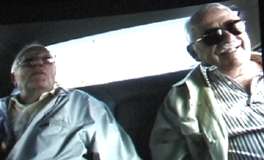 So with this "product"
in hand it made him feel as though he, at the very least, had
SOMETHING to show for what he had created and something to show
those interested in seeing his movie. So with this "product"
in hand it made him feel as though he, at the very least, had
SOMETHING to show for what he had created and something to show
those interested in seeing his movie.
Ted DID get offers from distributors but felt the deals they
had offered him represented bankruptcy for him so he turned them
all down and decided to self distribute. He felt if he could
get a few theatrical runs and a some good reviews, it would make
his "product" more attractive for the home video market.
With incredible persistence and a bit of moxie thrown in for
good measure, Ted simply called up certain theaters in the country
that he knew had video projection capability and booked the film.
Was it that easy? Well no, but it worked. And Ted had the Posters
and the CDs in hand to help market. He paid for a bit of advertising
per the theaters standard contract and would make 35% of the
gate in most cases negating the initial advertising costs. That's
providing someone showed up to buy a ticket. And by golly, they
did. Critics showed up after Ted rang them up and begged and
pleaded and shuffled with the truth a bit. Positive reviews generated
an easier time to go to the next city where he would get more
positive reviews.
The movies subject matter didn't hurt as anything with SEX in
the title helps sell interest. So Ted put it in twice.
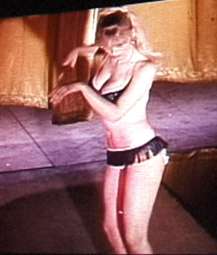 Ted had a difficult
time booking into certain theaters simply because that theatre
did not have a digital video projector and the owners were not
about to go out and buy a $100,000 system.. So with a deal he
made with Sharp and the American Cinematique, Ted put in a Sharp
P-20 projector (retail $9,000) at the Egyptian Theatre in LA,
hooked it up to a DVD player and tested it out on an audience.
It worked. Ted had a difficult
time booking into certain theaters simply because that theatre
did not have a digital video projector and the owners were not
about to go out and buy a $100,000 system.. So with a deal he
made with Sharp and the American Cinematique, Ted put in a Sharp
P-20 projector (retail $9,000) at the Egyptian Theatre in LA,
hooked it up to a DVD player and tested it out on an audience.
It worked.
So now, thanks to Ted and his persistence, Los Angeles has the
very first World class Cinema fully dedicated to digital movies,
and Mau Mau Sex Sex is playing on DVD in several theaters across
the country and no one knows the difference.
Ted will be writing a comprehensive article for lafcpug on self
distributing your digital movie soon. For now, read more on this
terrific film at maumausexsex.com
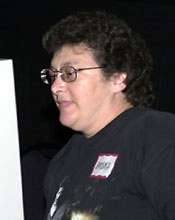 Following
my plea in one of the newsletters for more women to participate
in the meetings, Barbara Simon took the challenge and was up
next with a demo on "Compositing in FCP for the Absolute
Beginner." Barbara is one of the hardest working ladies
I have met in a long time and is relentless in her pursuit of
knowledge in both FCP and Motion Graphics. So we were lucky to
have her get up and give us a how 2 on getting started with the
compositing capabilities of FCP 2.0 Following
my plea in one of the newsletters for more women to participate
in the meetings, Barbara Simon took the challenge and was up
next with a demo on "Compositing in FCP for the Absolute
Beginner." Barbara is one of the hardest working ladies
I have met in a long time and is relentless in her pursuit of
knowledge in both FCP and Motion Graphics. So we were lucky to
have her get up and give us a how 2 on getting started with the
compositing capabilities of FCP 2.0
Using free Art beats graphics Barbara showed us a nifty animated
title sequence and then proceeded to show us how she did it.
Laying a background clip on Video 1 with the Title Safe area
in the Canvas window selected, Barbara then opened the Text Generator
and choose Axial Bold and typed in her title. She then selected
her duration as 5 seconds instead of the default 10. Upon completion
she dropped the text onto V2 using superimpose. Now she animated
the title to come from the top of the window down to the middle
and then out through the bottom using Key Frames in the Motion
tab of the Viewer window. (Read up on Key Frames, Folks)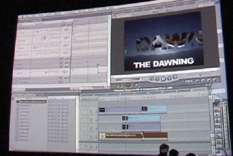 She then
COPIED that title onto Track 4 using Edit>Copy.Now drop some
video or a graphic onto track 3 which will go inside of the title
track on track 2 cause anytime you want video to appear inside
your text you must put it ABOVE the title track. Now go to Modify>
Composite>Travel Matte>Alpha to get video to appear within
text. She then scaled THAT title to begin at it's standard size
and slowly come towards you getting larger and larger until it
wipes screen. She of course used key frames. She then
COPIED that title onto Track 4 using Edit>Copy.Now drop some
video or a graphic onto track 3 which will go inside of the title
track on track 2 cause anytime you want video to appear inside
your text you must put it ABOVE the title track. Now go to Modify>
Composite>Travel Matte>Alpha to get video to appear within
text. She then scaled THAT title to begin at it's standard size
and slowly come towards you getting larger and larger until it
wipes screen. She of course used key frames.
Anyway, give it a try and thanks Barbara for braving the audience
and giving us this how 2.
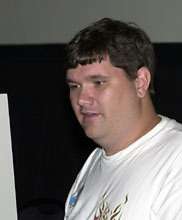 Next
up was Darren Purcell
of Fox Sports Net who along with a bunch of other folks produces
"Speed Truck Challenge" which appears here in
Los Angeles and through out the west. Darren brought in the timeline
to show us how he edits this 11 camera production which includes
several graphics tracks and many audio tracks. Speed Truck is
shot on Mini DV Cameras by the way. Next
up was Darren Purcell
of Fox Sports Net who along with a bunch of other folks produces
"Speed Truck Challenge" which appears here in
Los Angeles and through out the west. Darren brought in the timeline
to show us how he edits this 11 camera production which includes
several graphics tracks and many audio tracks. Speed Truck is
shot on Mini DV Cameras by the way.
Darren edited the race in only 8 hours but it took about 8 days
to do the graphics. At one time there were 22 layers of video
on the timeline including graphics and audio.Each camera had
it's own video track with the main camera on track 11. Darren
used markers to sync all the cameras up using flashes from the
crowds cameras.
Cameras were also mounted inside the trucks giving the viewer
a "you are there" experience.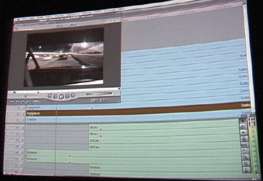
After syncing up the tracks, Darren merely cut from camera to
camera taking out sections as he went along. Very simple and
very elegant/
So, yes Virginia you can do a multi camera edit on FCP and do
it nicely with 11 cameras using the crowds flash cameras.
Darren has edited 5 of these shows and will shoot the next one
to air on Fox Sports Net the week of Thanksgiving.
 Next
up was Veteran ACE Editor Lillian Benson who, with her
more than 20 year experience using just about every NLE system
ever made, brings a wealth of stories to anyone wise enough to
stop her and ask a few questions. Next
up was Veteran ACE Editor Lillian Benson who, with her
more than 20 year experience using just about every NLE system
ever made, brings a wealth of stories to anyone wise enough to
stop her and ask a few questions.
Lillian showed us three pieces she did all on Final Cut Pro.
The first was a tribute to Academy Award Winning Editor Tom Rolfe
she did for the prestigious America Cinema Editors of which she
is a member. Featuring clips from this amazing mans life work,
it s jaw dropping, not for any great technical editing skill
on the part of Lillian, but for the body of work Tom Rolfe has
accomplished over his career. Lillian spent 2 days editing this
piece and about 5 days gathering the clips.
The next piece was a trailer from a HD feature she is currently
cutting called "Redemption," which is the story of
an African American Man who from what I can tell, is looking
for "Redemption." It is also noticeable for the stark
contrast of HD intercut with DV. You just have to see HD on a
big screen next to DV to really tell the difference. It's quite
stunning.
Lillian also showed us a documentary she cut for the WE Network
for their Extraordinary Women series. This particular episode
gave us a glimpse of Dolores Huerta, the co-founder of the United
Farm workers Union. The clip mixed archival footage of Dolores
on the front lines and interviews with her today. This remarkable
women is still very active today and this clip shows just how
active she remains. Best line of the clip: "If you were
stuck on a desert island, who would you rather be stuck with,
a Farm Worker or an attorney?"
 Next
up just before the break, was the much hyped, never before seen
on this planet, sure to wow every human being interested in this
kind of stuff, FCP tip/trick, seemingly discovered by accident
in a laboratory somewhere in the mountains of Romania and brought
to us by the one and only Andrew Balis of Moviola Education who discovered it in the
rubble of his apartment while eating a frozen entre' It is a
dandy and you can read about it by clicking HERE. Next
up just before the break, was the much hyped, never before seen
on this planet, sure to wow every human being interested in this
kind of stuff, FCP tip/trick, seemingly discovered by accident
in a laboratory somewhere in the mountains of Romania and brought
to us by the one and only Andrew Balis of Moviola Education who discovered it in the
rubble of his apartment while eating a frozen entre' It is a
dandy and you can read about it by clicking HERE.
Long first half so we all got up and
stretched and went into the lobby and looked at each others name
tags and ate food provided by our friends at Runway, before coming back for more FCP info
and laughs.
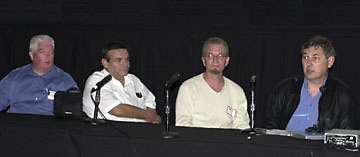 Coming
off the break we brought up three noted teachers of Final Cut
Pro from the ranks of the Public School System to share a little
about how they utilize FCP in the Classroom. John
Bishop from UCLA, Joseph
Karr O'Connor of Pasadena City College, and David
Arellano of Fulton Middle School in Van Nuys Ca each
showed footage of their respective video labs and talked briefly
on curriculum Time did not permit much more than a brief over
view of this subject, though lafcpug hopes to develop a symposium
dedicated to FCP in the Classroom for presentation sometime in
February 2002. We welcome any educators opinions and help on
this. Coming
off the break we brought up three noted teachers of Final Cut
Pro from the ranks of the Public School System to share a little
about how they utilize FCP in the Classroom. John
Bishop from UCLA, Joseph
Karr O'Connor of Pasadena City College, and David
Arellano of Fulton Middle School in Van Nuys Ca each
showed footage of their respective video labs and talked briefly
on curriculum Time did not permit much more than a brief over
view of this subject, though lafcpug hopes to develop a symposium
dedicated to FCP in the Classroom for presentation sometime in
February 2002. We welcome any educators opinions and help on
this.
 John Bishop showed us the
16 G4/DSR-20 workstations of the UCLA Video Arts school with
a patch bay that is an eye opener. Generally Arts students are
the ones who work on these machines. UCLA Video Arts school does
not teach software so it's up to the students to learn FCP them
selves or take a FCP class, so John leaves many materials around
to help them. DV Companion is installed on all G4s, instructors
have written numerous guides, multiple copies of Lisa Brenneis'
Book laying around, copies of the tutorials
that Ken Stone has written which you can find at Kenstone.net
or here at lafcpug also are available.
Instructors will hang around for part of the school day but the
lab is open 24 hours.Students share the hard drives. They use
the Multiple User control panel which gives you your own preferences
but with 2.0 there seems to be a bit of a bug with this method.
Seems upon creating a new user, after one creates his profile
and you launch FCP 2.0, up pops an error window telling you that
FCP needs a software key. Well Mark found away around this by
going to the FCP Data preferences and finding two FCP Data folders
(in this case) and copying the FCP User ID file from one of the
data folders into the other 'EMPTY' FCP Data folder. Works UCLA
does not assign partitions to each student John Bishop showed us the
16 G4/DSR-20 workstations of the UCLA Video Arts school with
a patch bay that is an eye opener. Generally Arts students are
the ones who work on these machines. UCLA Video Arts school does
not teach software so it's up to the students to learn FCP them
selves or take a FCP class, so John leaves many materials around
to help them. DV Companion is installed on all G4s, instructors
have written numerous guides, multiple copies of Lisa Brenneis'
Book laying around, copies of the tutorials
that Ken Stone has written which you can find at Kenstone.net
or here at lafcpug also are available.
Instructors will hang around for part of the school day but the
lab is open 24 hours.Students share the hard drives. They use
the Multiple User control panel which gives you your own preferences
but with 2.0 there seems to be a bit of a bug with this method.
Seems upon creating a new user, after one creates his profile
and you launch FCP 2.0, up pops an error window telling you that
FCP needs a software key. Well Mark found away around this by
going to the FCP Data preferences and finding two FCP Data folders
(in this case) and copying the FCP User ID file from one of the
data folders into the other 'EMPTY' FCP Data folder. Works UCLA
does not assign partitions to each student
 Joe O'Connor from Pasadena
City College was up next and brought in a full blown "commercial"
for the Digital media Arts Center, produced by the students specifically
for this occasion. Joe O'Connor from Pasadena
City College was up next and brought in a full blown "commercial"
for the Digital media Arts Center, produced by the students specifically
for this occasion.
PCC bought FCP the moment it came out in 1999 and has integrated
it into many of it's multimedia classes. PCC does not specifically
teach Final Cut but teaches Motion Graphics and "Digital
film Narrative" both of which utilize Final Cut. PCC has
20 G4s with FCP as near as I can tell and many have there own
NTSC monitor for preview.
PCC is gearing up for OSX but for now uses a program called "Assimilator"(sp)
on their OSX servers. This orphan program,will, upon the student
logging out, put the Mac back to what ever original condition
the program specifies, thus eliminating the need for constant
monitoring of student use. For more info on Assimilator(sp) write
Joe. Instructors FTP tutorials from home for use in the class
room the next day. It's an impressive set up, PCC.
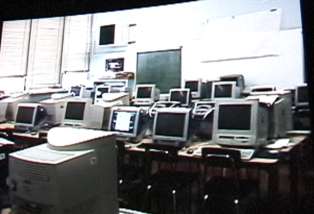 David Arellano
of Fulton Middle School was up next. Fulton Middle
School is part of the Los Angeles Unified School District and
like other public school systems through out the country has
it's own set of problems, lack of money being just one. David
teaches 150 students a day ranging from Special Ed to "very
bright." Most of his classes use iMovie but one will use
FCP specifically. David will teach the tool and then allow the
students to express themselves any way they wish. David will
teach FCP to his students by having them interview the "elective"
teachers and assemble a movie mixed with footage they film of
the teacher interacting with the students. Once they learn FCP,
David will have the students choose an historical moment, write
a script about that moment, and film that moment in front of
a blue screen using their own graphics they have drawn to depict
the background scenes. The students will also perform the roles.
David plans to buy chroma key paint and paint a wall of the gymnasium
providing he can get permission from the PE teacher. David Arellano
of Fulton Middle School was up next. Fulton Middle
School is part of the Los Angeles Unified School District and
like other public school systems through out the country has
it's own set of problems, lack of money being just one. David
teaches 150 students a day ranging from Special Ed to "very
bright." Most of his classes use iMovie but one will use
FCP specifically. David will teach the tool and then allow the
students to express themselves any way they wish. David will
teach FCP to his students by having them interview the "elective"
teachers and assemble a movie mixed with footage they film of
the teacher interacting with the students. Once they learn FCP,
David will have the students choose an historical moment, write
a script about that moment, and film that moment in front of
a blue screen using their own graphics they have drawn to depict
the background scenes. The students will also perform the roles.
David plans to buy chroma key paint and paint a wall of the gymnasium
providing he can get permission from the PE teacher.
Prior to FCP and iMovie, David exclusively used HyperStudio and
continues to utilize it today on some of the older Macs. Fulton
has 2 FCP and one PhotoShop workstations on iMacs mixed in with
several Mac 5500s. All use Multi User.
David finds that the students who are having trouble reading
often excel in his class simply because video allows another
way to express themselves and sometimes that expression leads
to better reading skills.
These three teachers are pioneers along with hundreds of others
throughout the world. They are struggling to find the best methods
of dealing with the demands of this new technology as well as
the demand for this form of expression. Each new version of Final
Cut presents it own set of problems and it's own set of work
arounds but in the end the result is what matters; stories are
being told.
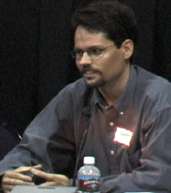 Filmmaker
Scott Peterson assembled
members of Chicago's famed 2nd City improvisation troupe and
allowed them the freedom they so well deserve and came up with
a beauty of a film titled "A Buck and Change" Shot
documentary style with an XL1 and VX1000 with a shutter speed
of 30fps (to give it that "less like video" look) this
movie is note worthy for the performances of the cast and the
tight and expertly edited dialogue. Filmmaker
Scott Peterson assembled
members of Chicago's famed 2nd City improvisation troupe and
allowed them the freedom they so well deserve and came up with
a beauty of a film titled "A Buck and Change" Shot
documentary style with an XL1 and VX1000 with a shutter speed
of 30fps (to give it that "less like video" look) this
movie is note worthy for the performances of the cast and the
tight and expertly edited dialogue.
It's the story of a group of Pizza delivery people and their
"issues" with life, with emphasis on one particular
driver named Drake. Performances are uniformly excellent, but
what is remarkable, is that you grow to know and really like
these people in such a short time. Testimony to the skill of
director Scott Peterson and his tightly woven "script."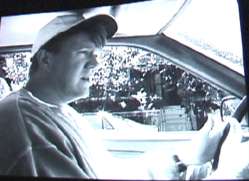
This is a very funny movie that deserves to be seen and one can
only hope that happens. If it doesn't then how about making a
sequel. We are all dying to know what they are doing today. Special
mention must be paid to Don Bardwell as Drake. What a find this
guy is. Heck, what a find the entire cast is.
World famous raffle was up next and the following prizes were given
away.
T-shirt - Kenstone.net
T-Shirt- creativecow.net
T-shirt - Promax
Mau Mau Sex Sex Poster - Ted
Bonnitt
CDR Labels - Meritline
Blank DVD - Meritline
2 Speed Truck Challenge T-shirts - Darren Purcell
2- Speed Truck Challenge Hats - Darren Purcell
Secrets of Final Cut Pro CD- Dvcreators.net
PowerStart Guide2 CD - Dvcreators.net
DV Companion - Intelligent Assistance
2 copies of Final Draft and Final Draft AV - Final Draft
1 free 3 day FCP 101 class at Moviola - Moviola Education
3 TDK Mini DV Tapes - TDK
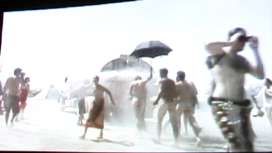 Right
after the raffle Steve Payne showed a clip from his latest,
titled Burn Baby Burn, a documentary on the annual Burning Man
Festival held each summer in Nevada. It's not fair to write a
full review of it here but suffice it to say, if you have a chance
to see this film, do so, as it not only takes you inside this
unique and strange gathering, but illuminates what it is REALLY
all about. http:/www.paynie.com Right
after the raffle Steve Payne showed a clip from his latest,
titled Burn Baby Burn, a documentary on the annual Burning Man
Festival held each summer in Nevada. It's not fair to write a
full review of it here but suffice it to say, if you have a chance
to see this film, do so, as it not only takes you inside this
unique and strange gathering, but illuminates what it is REALLY
all about. http:/www.paynie.com
Special thanks go to Ken Stone for taking pics, Chris Coe
and Doug Lindeman for taking tickets, Dan Brockett for taping the show, and of course Promax for footing the bill.
See you all Oct 24 when we will try one
more time to get it right.
Michael Horton,
|